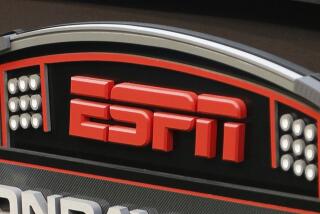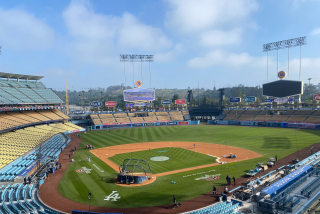Getting Hooked on Cable Sports : Pay TV Competition Begins to Resemble Playing-Field Rivalry
- Share via
Sports? You want sports? Cable’s got sports. So many non-stop athletic contests, in fact, that the average fan might just die of exhaustion in front of the TV set.
Sports programming in Southern California has exploded.
Today, thanks to cable, any fan of any sport--from basketball to billiards to baseball--can have a front-row seat in living-room comfort. In addition to the decade-old, all-sports national cable channel, Connecticut-based ESPN, two Los Angeles-based sports channels have popped up on cable during the past four years.
One of them, the Z Channel, is abandoning its current format of movies and sports this week to go all sports. SportsChannel Los Angeles, which debuts Friday, currently has exclusive rights to selected Dodgers, Angels and Clippers games.
Ironically, the other channel, Prime Ticket Network, has cable rights to the Lakers, Kings and the Pac 10, potentially setting up the kind of head-to-head competition for sports viewers’ loyalty that usually turns up on the playing field.
How do the executives who run the cable sports business explain the recent upsurge? They claim that cable sports hit the fast track when the middle class got priced off the court and out of the ballpark.
“Even if you wanted to, you can’t buy a ticket to go across the street and see a Laker game,” said John Severino, president of Prime Ticket, which is headquartered across the street from the Forum in Inglewood.
Nearly every home game of the defending NBA championship team was a sellout this year. All the best seats went to season ticket holders long before the first game was ever played. If tickets could be had at all, they generally went at prices well above the $11.50 face value.
But Prime Ticket televised 31 of the Laker home games this year. For the price of a basic cable hook-up (about $20 a month), 3.5 million subscribers got to see them all, plus a lineup of UCLA and USC football games, professional soccer, tennis tournaments, professional volleyball and ice hockey.
During the past six months, the 4-year-old sports network also televised 27 home and 33 road games of Wayne Gretzky and the Los Angeles Kings hockey team.
“Next year, they’ll be just like the Lakers,” Severino predicted. “You probably won’t be able to buy a ticket to see a Kings game, even if you had the money.”
Los Angeles has come late to cable sports.
Touted as the wave of the future, cable began catching on in other metropolitan areas across the United States as early as 20 years ago. But only recently has the Los
Angeles area been wired for cable to any significant degree. There are still patches of mountain and desert that can’t get cable, and TV household “cable resistance,” as it’s known in the television industry, persists in the greater Los Angeles area, where slightly more than half the homes that could subscribe choose not to.
There are several explanations for Los Angeles residents’ resistance and the equally slow development of cable sports, beginning with the weather.
“There’s 310 days of sunshine a year in Southern California,” said Rockey Flintermann, who has been programming director for Santa Monica-based Z Channel and will continue in that position for SportsChannel Los Angeles. “People can watch a football game at 10 a.m. (on one of the broadcast networks) and play touch football themselves by 1:30 p.m.”
“Or watch two games and play football at 4 p.m.,” said Z Channel president Joseph Cohen.
Another reason Los Angeles has come late to cable sports, according to Cohen, is the panoply of over-the-air broadcast offerings. There are seven VHF stations and another 11 UHF stations serving Los Angeles, most of which offer some sports from time to time.
“You also have to remember that ON-TV was a very successful over-the-air pay-TV service that went on the air in April, 1977,” said Flintermann. “They had the Lakers, Dodgers, Angels and the Kings. ON-TV probably postponed the wiring of Los Angeles by 10 years.”
At its peak in 1981, ON-TV had 380,000 subscribers who paid $39.95 for installation and $18.95 a month. For the next two years, ON-TV dominated the local pay-TV market. (By the time the combination movie and sports pay-TV service sold out to rival SelecTV in 1985 for a reported $18 million, however, cable and the growing popularity of videocassettes had cut its subscription base to 156,000.)
To pick up where ON-TV left off, Lakers owner Jerry Buss formed a partnership with Denver businessman Bill Daniels and created the Prime Ticket Network in 1985. With Buss’ teams as its mainstay, Prime Ticket began selling its evening-only telecasts of basketball and hockey to dozens of local cable TV services throughout Southern California and, eventually, Nevada, Arizona and Hawaii.
It was another two years before the Z Channel followed Prime Ticket’s example, buying up the cable rights to the Dodgers, Angels and Clippers. The quirky Westside cable TV service, whose reputation revolved around airings of unusual or hard-to-find old movies, had begun to learn a tough lesson from the VCR revolution.
“You can go to the video store and find an old movie--even an obscure old movie,” said Z Channel’s Cohen. “You can’t go to a video store and buy tonight’s ballgame.”
That simple wisdom will turn the Z Channel into a full-time sports cable programmer on Friday. Unlike Prime Ticket, which is included in the cost of basic cable service, Z Channel has been a pay channel, meaning that cable subscribers pay an additional monthly premium of $10-$14 to receive it. So far, 135,000 subscribers have opted to pay that premium, up from about 85,000 when it acquired Dodger and Angel cable rights a year ago.
The rechristened SportsChannel Los Angeles hopes eventually to reach 2 million subscribers in four states: Arizona, Nevada, California and Hawaii. At a press conference last week, SportsChannel officials said that subscribers in the Los Angeles area will be charged from $6 to $8 a month, but that there may be no additional charge beyond the basic cable subscription rate for viewers outside the Los Angeles area.
According to Severino, there are no plans to make cable subscribers pay a Z Channel-type premium for Prime Ticket, which is hoping to expand its sports programming beyond its current 5 p.m. to midnight daily offering.
With 3.5 million potential viewers on more than 100 different cable systems, Prime Ticket counts five kinds of beer and 21 other brands of oil, soft drink, automobile and other nationally known products among its advertisers. And, thanks to the success of the Lakers, Kings and both UCLA and USC football teams this past year, the rates those advertisers are charged have been moving up “accordingly,” Severino said.
“Advertisers are now realizing that it is probably in their best interests to be on cable,” he said. “In fact, we are now accepting advertising from broadcast network sports and entertainment departments for the first time.”
In an effort to extend its reach even further, Prime Ticket recently affiliated with three other regional networks: Prime Sports Network, serving Colorado, New Mexico, Wyoming, Nebraska and Kansas; Home Sports Entertainment, serving Texas, Louisiana, Oklahoma, Arkansas and New Mexico; and Sunshine Network, serving Florida. This new network reaches 9 million viewers, boosting advertising sales potential and expanding available programming for each of its member networks.
The owners of the national SportsChannel America program service likewise had a national network in mind when they bought Z Channel. SportsChannel’s parent firm, New York-based Cablevision Systems Corp., also owns six other regional cable operations in New York, New England, Chicago, Florida, Ohio and Philadelphia.
The networking will help sate the never-ending appetite for sports programming, according to officials of both Prime Ticket and SportsAmerica. Besides regular series, such as a local sportswriters’ panel on SportsAmerica, the best games from other regional networks can be taped and aired on an affiliated regional network the same day.
“An even more exciting prospect is the switching around,” said Z Channel’s Flintermann. “Say you’ve got a game that’s turning into a runaway in Cleveland. You just switch to a no-hitter in Texas!”
ESPN President Roger Werner does not see regional operations such as Prime Ticket and the Z Channel as direct competition to his sports network, which has the highest penetration of any cable programmer in the country. (ESPN reaches 50.9 million of the nation’s 90.4 million homes, CNN 50.2 million and WTBS 49.1 million, according to the A.C. Nielsen Co.’s March, 1989, survey of cable subscribers.)
“At least for now, regional services are complementary to us,” he said. “They are tapping local advertising markets, but they’re not really a competitor for national advertising dollars.”
The new regional network that SportsChannel is creating and the coalition of regional services that Prime Ticket has assembled may eventually threaten ESPN’s pre-eminence and its national advertising sales, but two months shy of its 10th anniversary, the nation’s first all-sports network is very secure, Werner said.
“We remain strong and successful by keeping an eye on customer value. I don’t see any reason to change that operating philosophy.”
Werner’s advice to upstarts like Prime Ticket and Z Channel is simple: Keep presenting high-interest local sports at affordable prices.
“I would caution them to keep their eye on customer value,” he said. “Watch their prices. Don’t believe that the consumer’s wallet or bank account is limitless.”
But if players’ salaries and other team operating costs keep climbing, driving up TV rights fees, and if cable companies cannot recoup their investment through advertising sales, the only other revenue source would appear to be increased cable subscription rates.
“Advertising and subscription rates will probably both go up over time,” Werner acknowledged. But ESPN’s $400-million, 4-year deal with Major League Baseball will not force the service to become a pay-cable operation, he added.
“You never say ‘never,’ ” Werner said. “I can’t say that in 10 years we won’t be (a pay service like the Z Channel), but I can’t see any significant probability of that happening.”
COMPARING THE CABLE SERVICES SPORTSCHANNEL L.A. (begining Saturday) Number of subscribers: 117,000 Subscriber Cost:--$10 to $14 a month in addition to Basic Cable charge Hours of Programming:--(Though it currently airs movies and sports 24 hours a day, Z Channel will change its hours when it becomes all sports on July 1: weekdays, programming will air from 2 p.m. to 1 a.m. and weekends, 10 a.m. to 1 a.m.) Programming: Dodgers Angels Clippers Stanley Cup playoffs Sports America Pro Boxing Tour (weekly fights) Amateur boxing, including U.S.A.-U.S.S.R. series Italian League soccer Pro golf, including the Crosby Celebrity Tournament and the Lancia Italian tour Pro tennis, including the MONY Tournament of Legends and the MacKenzie Challenge of Champions Ladies pro bowling tour Loyola Marymount basketball Basketball, including the World Basketball League and Junior Olympic basketball (matches the AAU against the USSR) College lacrosse Equestrian jumping and steeple chase A weekly half hour “Sportswriters on TV” program, originating from Los Angeles “Sports Nightly,” a regular evening wrapup of the day in sports PRIME TICKET Number of Subscribers:--3.5 million Subscriber Cost:-- Included in Basic Cable subscription fee (usually about $20 per month) Hours of Programming:--5 p.m. to 12 a.m. daily Programming: Lakers Kings Lazers soccer San Diego Sockers soccer Los Angeles Strings tennis Team Cup volleyball Fight Night at the Forum Michelin Tennis Challenge Pro Beach volleyball Arena Football League NCAA, Pac-10, Big West and Western Athletic Conference football, basketball, volleyball, track & field, tennis, swimming, baseball, crew, gymnastics, soccer, water polo, softball and golf CIF High School Sports Beat Horseracing recaps from Hollywood Park, Santa Anita, Del Mar and Fairplex Park “It’s Your Call” live phone-in talk show Hourlong “Sportswriters on TV” show originating from Chicago
More to Read
Go beyond the scoreboard
Get the latest on L.A.'s teams in the daily Sports Report newsletter.
You may occasionally receive promotional content from the Los Angeles Times.










